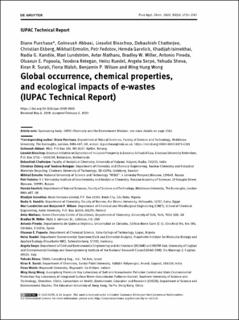| dc.contributor.author | Purchase, Diane | |
| dc.contributor.author | Abbasi, Golnoush | |
| dc.contributor.author | Bisschop, Lieselot | |
| dc.contributor.author | Chatterjee, Debashish | |
| dc.contributor.author | Ekberg, Christian | |
| dc.contributor.author | Ermolin, Mikhail | |
| dc.contributor.author | Fedotov, Petr | |
| dc.contributor.author | Garelick, Hemda | |
| dc.contributor.author | Isimekhai, Khadijah | |
| dc.contributor.author | Kandile, Nadia G. | |
| dc.contributor.author | Lundström, Mari | |
| dc.contributor.author | Matharu, Avtar | |
| dc.contributor.author | Miller, Bradley W. | |
| dc.contributor.author | Pineda, Antonio | |
| dc.contributor.author | Popoola, Oluseun E. | |
| dc.contributor.author | Retegan, Teodora | |
| dc.contributor.author | Ruedel, Heinz | |
| dc.contributor.author | Serpe, Angela | |
| dc.contributor.author | Sheva, Yehuda | |
| dc.contributor.author | Surati, Kiran R. | |
| dc.contributor.author | Walsh, Fiona | |
| dc.contributor.author | Wilson, Benjamin P. | |
| dc.contributor.author | Wong, Ming Hung | |
| dc.date.accessioned | 2020-11-16T14:19:17Z | |
| dc.date.available | 2020-11-16T14:19:17Z | |
| dc.date.created | 2020-11-12T09:14:53Z | |
| dc.date.issued | 2020 | |
| dc.identifier.citation | Pure and Applied Chemistry. 2020, 92, 1733-1767. | en_US |
| dc.identifier.issn | 0033-4545 | |
| dc.identifier.uri | https://hdl.handle.net/11250/2688075 | |
| dc.description.abstract | The waste stream of obsolete electronic equipment grows exponentially, creating a worldwide pollution and resource problem. Electrical and electronic waste (e-waste) comprises a heterogeneous mix of glass, plastics (including flame retardants and other additives), metals (including rare Earth elements), and metalloids. The e-waste issue is complex and multi-faceted. In examining the different aspects of e-waste, informal recycling in developing countries has been identified as a primary concern, due to widespread illegal shipments; weak environmental, as well as health and safety, regulations; lack of technology; and inadequate waste treatment structure. For example, Nigeria, Ghana, India, Pakistan, and China have all been identified as hotspots for the disposal of e-waste. This article presents a critical examination on the chemical nature of e-waste and the resulting environmental impacts on, for example, microbial biodiversity, flora, and fauna in e-waste recycling sites around the world. It highlights the different types of risk assessment approaches required when evaluating the ecological impact of e-waste. Additionally, it presents examples of chemistry playing a role in potential solutions. The information presented here will be informative to relevant stakeholders seeking to devise integrated management strategies to tackle this global environmental concern. | en_US |
| dc.language.iso | eng | en_US |
| dc.rights | Attribution-NonCommercial-NoDerivatives 4.0 Internasjonal | * |
| dc.rights.uri | http://creativecommons.org/licenses/by-nc-nd/4.0/deed.no | * |
| dc.title | Global occurrence, chemical properties, and ecological impacts of e-wastes (IUPAC Technical Report) | en_US |
| dc.type | Peer reviewed | en_US |
| dc.type | Journal article | en_US |
| dc.description.version | publishedVersion | en_US |
| dc.rights.holder | © 2020 IUPAC & De Gruyter. | en_US |
| dc.source.pagenumber | 1733-1767 | en_US |
| dc.source.volume | 92 | en_US |
| dc.source.journal | Pure and Applied Chemistry | en_US |
| dc.identifier.doi | 10.1515/pac-2019-0502 | |
| dc.identifier.cristin | 1847238 | |
| dc.relation.project | Norges forskningsråd: 303182 | en_US |
| dc.relation.project | NILU - Norsk institutt for luftforskning: 120019 | en_US |
| cristin.ispublished | true | |
| cristin.fulltext | original | |
| cristin.qualitycode | 1 | |

